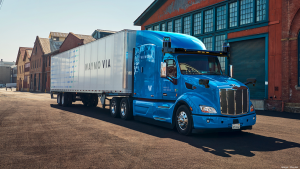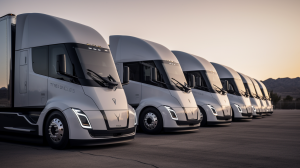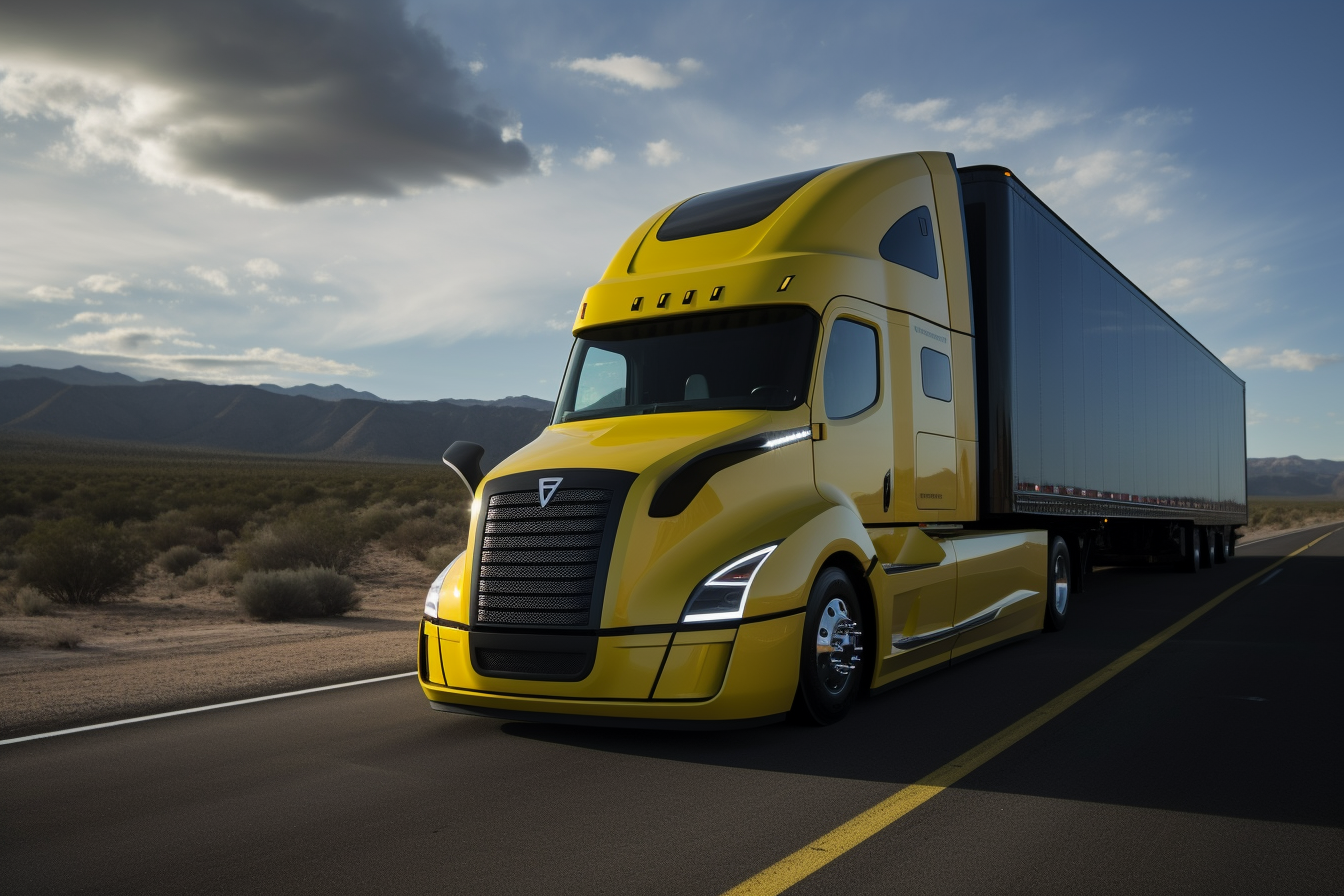Exclusive Content!
TThe Autonomous Trucks Logistics Revolution has begun, and it’s already making a significant impact on the logistics landscape. As self-driving truck technology advances, it’s transforming the way goods are transported, improving supply chain efficiency, reducing transportation costs, and providing a range of environmental benefits. In this article, we’ll delve into five key ways autonomous trucks are changing the logistics industry, from driverless technology to vehicle connectivity, while also addressing potential harms, job losses, and pitfalls of the technology.

As self-driving truck technology advances, it’s transforming the way goods are transported, improving supply chain efficiency, reducing transportation costs, and providing a range of environmental benefits. (CH Robinson Waymo VIA Autonomous Truck)
Autonomous Trucks Logistics Revolution: Key Developments
Driverless Technology’s Emergence in Logistics
Understanding Autonomous Truck Functionality
Autonomous trucks use a combination of sensors, cameras, and advanced algorithms to navigate their environment without human intervention. These self-driving vehicles are typically equipped with a range of technologies, such as LiDAR, radar, GPS, and computer vision systems, which enable them to perceive and respond to their surroundings.
Truck Automation Levels

There are six levels of automation in vehicles, ranging from Level 0 (no automation) to Level 5 (full automation).
There are six levels of automation in vehicles, ranging from Level 0 (no automation) to Level 5 (full automation). Autonomous trucks in the logistics industry are currently at Level 3 (conditional automation) or Level 4 (high automation), meaning they can perform most driving tasks but may still require human intervention in certain situations.
Enjoying our insights?
Subscribe to our newsletter to keep up with the latest industry trends and developments.
Stay InformedAdvantages of Driverless Trucks for Logistics
The introduction of autonomous trucks into the logistics sector offers numerous benefits, including increased efficiency, reduced transportation costs, and enhanced safety. By removing the need for human drivers, companies can optimize their delivery routes, reduce the risk of accidents, and lower labor costs.
Boosting Supply Chain Efficiency with Vehicle Connectivity
V2V Communication in Autonomous Trucks

Using vehicle-to-vehicle (V2V) communication, trucks can exchange information about their position, speed, and direction with other vehicles on the road. (Daimler Autonomous Truck Platoon}
One of the most significant advancements in autonomous truck technology is vehicle connectivity. Using vehicle-to-vehicle (V2V) communication, trucks can exchange information about their position, speed, and direction with other vehicles on the road. This enables them to coordinate their movements, optimize traffic flow, and reduce the risk of collisions.
Fuel Efficiency through Platooning
An application of V2V communication in the logistics industry is platooning, where multiple autonomous trucks travel in close proximity to reduce air resistance and improve fuel efficiency. This can lead to significant fuel savings and lower greenhouse gas emissions.
Accessing Real-Time Supply Chain Information
Vehicle connectivity also allows logistics companies to access real-time data about their shipments, helping them to make more informed decisions and improve overall supply chain efficiency.
Lowering Transportation Expenses through Autonomous Trucks
Decreased Labor Expenses

One of the most significant cost savings associated with autonomous trucks is the reduction in labor costs. (TuSimple Autonomous Truck)
One of the most significant cost savings associated with autonomous trucks is the reduction in labor costs. By eliminating the need for human drivers, companies can significantly reduce their payroll expenses.
Savings in Long-Haul Trucking
This is particularly beneficial for long-haul trucking, where driver wages and benefits can account for a substantial portion of a company’s transportation costs. Additionally, autonomous trucks can operate continuously, allowing for faster and more efficient deliveries.
Reduced Insurance Premiums
Autonomous trucks also have the potential to reduce insurance premiums for logistics companies. As self-driving trucks are expected to have fewer accidents, insurance companies may offer lower rates to businesses that adopt the technology.
Enhancing Safety in Logistics
Minimizing Human Error in Trucking
Human error is a leading cause of accidents in the trucking industry. By automating driving tasks, autonomous trucks can minimize the risk of accidents caused by factors such as driver fatigue, distraction, or impaired judgment. With advanced sensors and algorithms, self-driving trucks are better equipped to react to potential hazards and maintain safe driving conditions.

By automating driving tasks, autonomous trucks can minimize the risk of accidents caused by factors such as driver fatigue, distraction, or impaired judgment.
Preventing Accidents Proactively
Autonomous trucks are designed to proactively prevent accidents by continuously monitoring their surroundings and making real-time adjustments to their driving behavior. For example, they can automatically maintain a safe following distance, adjust their speed according to traffic conditions, and brake promptly in response to obstacles.
Autonomous Trucks’ Environmental Advantages in Logistics
Autonomous trucks can also improve safety by facilitating more efficient vehicle maintenance. With built-in diagnostic systems, these trucks can detect potential issues and alert fleet managers, allowing for prompt repairs and reducing the likelihood of mechanical failures on the road.
Environmental Benefits of Autonomous Trucks in Logistics
Lowering Fuel Consumption

Autonomous trucks also have the potential to accelerate the adoption of electric and hybrid vehicles in the logistics industry.
As previously mentioned, autonomous trucks can improve fuel efficiency through techniques such as platooning. Additionally, their advanced driving systems can optimize acceleration and braking patterns, further reducing fuel consumption.
Reducing Greenhouse Gas Emissions
By reducing fuel consumption, autonomous trucks can help lower greenhouse gas emissions in the logistics industry. This is particularly important as the transportation sector is a significant contributor to global emissions, and adopting more environmentally-friendly technologies can play a crucial role in combating climate change.
Electric and Hybrid Trucking Solutions
Autonomous trucks also have the potential to accelerate the adoption of electric and hybrid vehicles in the logistics industry. By combining driverless technology with cleaner energy sources, companies can significantly reduce their environmental impact.
In conclusion, the Autonomous Trucks Logistics Revolution is reshaping the logistics landscape in numerous ways. From enhancing supply chain efficiency and reducing transportation costs to improving safety and offering environmental benefits, the adoption of autonomous trucks promises a brighter and more sustainable future for the logistics industry. However, it is essential to consider the potential harms and challenges that come with this revolution.
Addressing Potential Risks and Obstacles:
- Job displacement: The widespread adoption of autonomous trucks could potentially lead to job losses in the trucking industry, affecting millions of drivers.
- Cybersecurity concerns: As autonomous trucks rely on advanced software and connectivity, they may be vulnerable to cyber-attacks, which could lead to data breaches, theft, or even accidents.
- Technical challenges: Autonomous truck technology is still in its early stages, and there might be several technical challenges to overcome, such as improving sensor accuracy in extreme weather conditions or navigating through complex road situations.
- Regulatory hurdles: The implementation of autonomous trucks will require new laws and regulations, which might take time to develop and adapt to these advancements in technology. This could slow down the adoption of autonomous trucks in the logistics industry.
- Ethical concerns: The use of autonomous trucks raises ethical questions about decision-making in emergency situations, where the truck’s AI might need to choose between multiple unfavorable outcomes.
- Liability issues: In the event of an accident involving an autonomous truck, determining responsibility can be complex, as it might involve the manufacturer, software developer, or the trucking company.
- Public perception: There might be resistance from the public due to concerns over safety, job losses, and other factors, which could slow down the adoption of autonomous trucks in the logistics industry.
- Infrastructure requirements: The implementation of autonomous trucks might necessitate the development of dedicated lanes, charging stations, and other infrastructure components, which could be costly and time-consuming to establish.
Navigating Unforeseen Developments and Hurdles
While the Autonomous Trucks Logistics Revolution holds immense promise for transforming the logistics industry, it is important to consider the potential unforeseen advances, inventions, and challenges that could affect the adoption of this technology. The rapidly evolving field of AI could lead to new developments in algorithms, sensor technology, communication systems, or entirely new applications that could either complement or disrupt the logistics industry.
On the other hand, factors such as regulatory barriers, cybersecurity concerns, public perception, and economic conditions could hinder the widespread adoption of autonomous trucks. As the industry progresses, it is crucial for all stakeholders, to diligently observe and adapt to the constantly changing landscape of AI technology. By doing so, they can ensure that the advantages of autonomous trucks are fully realized, while simultaneously addressing any potential challenges and concerns that may emerge in the future.
By acknowledging and addressing these potential harms and challenges, the logistics industry can work towards ensuring a more sustainable and responsible transition to autonomous trucking technology.
Explore more News on Autonomous Technology in the Trucking Industry:
- 24/7 Autonomous Freight Service Dallas-Atlanta Revolutionizes Trucking Industry
- The Future of Tank Transportation in 2023 & Beyond
- Embark and Knight-Swift Launch Program
- Feds Reviewing Autonomous Truck Mishap
External Resources:





















